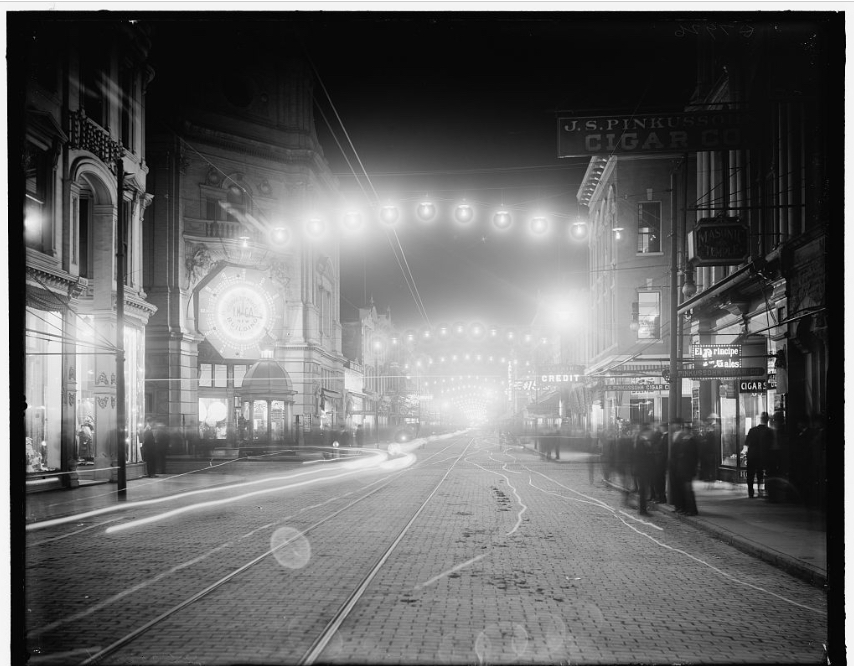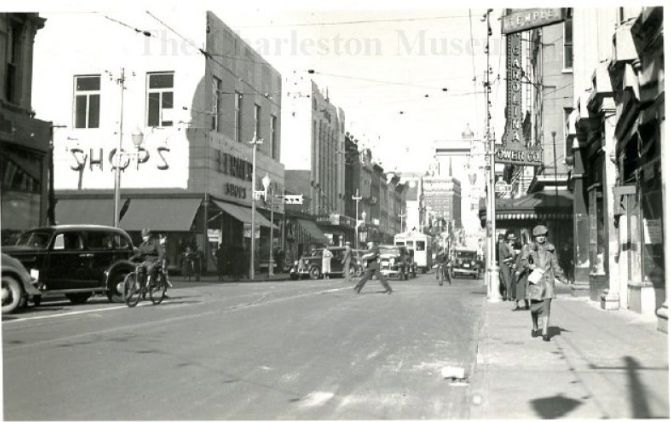HIRSCH-ISRAEL BUILDING
“A gorgeousness equaled only by a chapter in the ‘Arabian Nights’” is how Charleston’s Evening Post described the Hirsch-Israel Building when it opened in January 1897. The enthusiastic reporter goes on to devote four full columns of broadsheet newsprint to describing nearly every exterior and interior detail of the new clothing store on the corner of King and Wentworth streets, calling it “[t]he pride of the city, even pride of the State.”
Designed by architect Paul J. Pelz (who also designed the Library of Congress), this monumental, three-story Baroque Revival structure was the most exuberantly designed store ever built along King Street’s historic commercial corridor. With a grandiose granite façade, its notable features included a domed tower of gold-colored tiles that brilliantly reflected the sunlight, a 42-foot cupola, a grand staircase of solid oak, and an exterior clock that boldly proclaimed the company’s brand: Hirsch-Israel Company.
The company was a partnership between Isaac W. Hirsch (1844-1925) and Arthur Israel (1868-1931), members of Kahal Kadosh Beth Elohim synagogue, who ran a clothing business in a rented space across the street before building this magnificent structure.
Because of a death in the family, its grand opening celebration was more restrained than originally planned. “But notwithstanding the simple preparations,” the Evening Post reported, “the event was, to the thoughtful Charlestonian, of such great importance that it was accepted as an epoch in Charleston’s business history.”
Single plates of French glass 17 feet wide and nine feet tall were framed by “gracefully designed” Indiana limestone. A Gothic arch formed the main entrance, set at a 45-degree angle from the corner, thus addressing both streets at the intersection, with 14-foot terra cotta bas relief carvings of mythical women representing Fashion and Commerce on either side.
Its highest point, the Observation Room rose 84 feet above ground with a “grand view up King Street … which repays the climber.” A post office on the ground floor was a “great convenience and one of the greatest improvements in the postal system that has fallen to Charleston’s lot,” the Evening Post’s coverage continued. Eight chandeliers (four electric, four gas) bathed the first floor in light, with similar lighting on the second and third floors. The building’s modern coup de grace, an electric elevator, magically transported customers among the floors.
Hirsch eventually sold his interest in the company to Israel who, in 1919, sold the building to the Dime Savings Bank and retired. With architectural tastes much more restrained following the Great Depression, its new owners deconstructed the building to the point of being unrecognizable, tearing down the great dome and replacing the ornate granite façade with unremarkable yellow brick. Its freestanding display case, at the corner’s intersection, was moved to a private residence on Rutledge Avenue, where it became a garden folly.
Numerous retail businesses have rotated through the site since then, including a Lerner Shops, part of a national discount department store chain. Currently it houses a Vineyard Vines clothing chain store. One of its many renovations, in 1996, revealed remnants of the surviving framing of the upper floors, but that was all.




